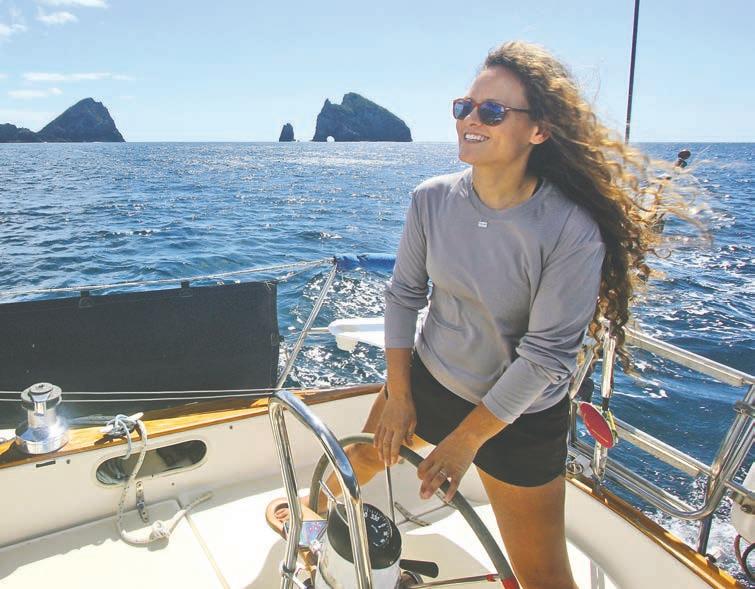
35 minute read
sightings
clipper race scrambles in asia
Everywhere around the world in March, travelers received the message, "Welcome to (fi ll in the blank); now go home." A variation of this is exactly what happened to the sailors aboard the fl eet of 11 70-ft monohulls in the Clipper Race around the world. The microbes hit the fan during the Clipper's passage from Airlie Beach, Australia, to Sanya, China. "At some point during Race 6, well after the boats had left Airlie Beach, Clipper made the decision that they would not go to Sanya due to the virus," explains Clipper crew Harmon Shragge. "They decided that the boats would race directly to Subic Bay. After the boats arrived in Subic Bay, Race 7 changed to an 8- to 12-day jaunt to off the coast of Taiwan." Harmon bought his fi rst ticket from SFO to Hong Kong in late January. He canceled that (and got a full refund due to the virus) and purchased a ticket from SFO to Manila with one stop in Korea. "After I saw the virus explode in Korea, I canceled that fl ight (no refund, but I will receive full credit). I purchased a ticket on Philippine Airlines from SFO to Manila landing March 3. (I used that ticket.)
Advertisement
continued on outside column of next sightings page
news of
In 'Lectronic Latitude during the month of March, we kept a running tally of events canceled, postponed, or moved online.
The biggest event affected — and the one garnering the biggest headlines worldwide — is the Summer Olympic Games, scheduled to begin on July 24 in Tokyo and environs. Japan was one of the early countries to record instances of the novel coronavirus — before the World Health Organization declared a pandemic. In the second week of March, regattas that qualify sailors for their country's spots on the team began canceling (as did trials in other sports). During the third week of March, both Canada and Australia withdrew from the Olympics out of concern for their citizens. On March
Just one of the guys — Clipper Race founder Sir Robin Knox-Johnston hangs out behind the locked gate with the crews in Subic Bay. With him is San Francisco sailor Harmon Shragge, our correspondent for this adventure. Harmon sails aboard 'Visit Sanya, China'. (That's the name of the yacht in this edition, but also its sponsor.) Lower right: The trash piled up for a while on the docks.
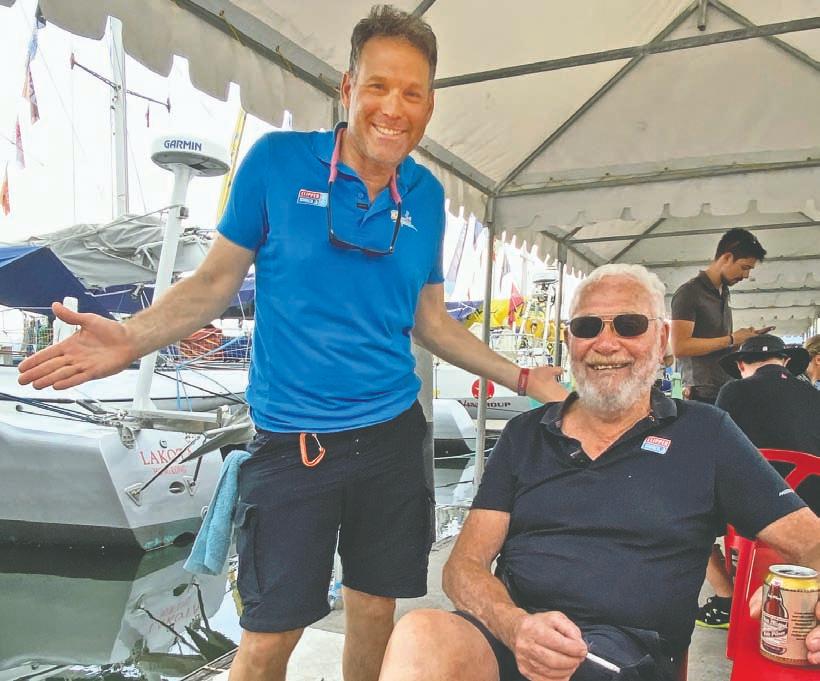
the world
24, the president of the International Olympic Committee (IOC), Thomas Bach, and Prime Minister Shinzo Abe, jointly announced that the 2020 Olympiad would be "rescheduled to a date beyond 2020 but not later than summer 2021." Another country affected early on was hard-hit Italy. The first America's Cup World Series event had been scheduled for Cagliari, Sardinia, in late April. "It is quite obvious that the ACWS Cagliari event cannot go ahead," noted the Defender. A couple of weeks later, organizers also pulled the plug on June's ACWS regatta in Portsmouth, UK. The final ACWS event, to be held in Auckland in December, remains on the books.
— chris
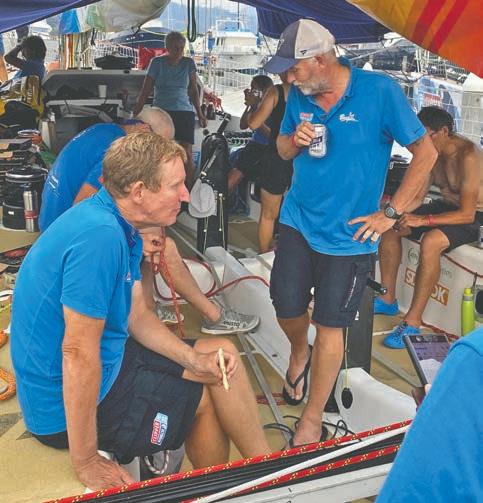
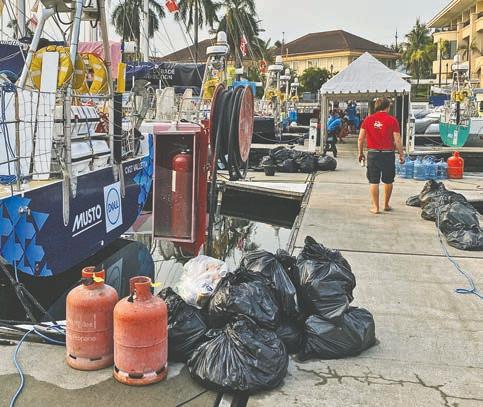
HARMON SHRAGGE
clipper race — continued
"The major expansion of the virus had not yet taken place in the US or in the Philippines, so landing there was a non-issue. Not one sign of it anywhere. The first sign that there was no normal anymore came on March 5 or 6. Clipper let it be known that while we were still planning to race to Seattle, they did not know when we would leave Subic Bay. They did not want to race directly from Subic to Seattle. They were committed to providing their sponsors an interim race, plus for health and safety reasons they wanted us to get some time to train as a team on our individual boats before we tackled the North Pacific. So we spent our days cleaning and repairing our boats and enjoying the best of Subic Bay by night. The local population is friendly and outgoing. But the local scenery and nightlife are about as fun as an old rundown Navy base could be. "By March 7, Clipper made the big announcement that we would sail nonstop from Subic to Seattle at a date to be determined. Sir Robin told us that trip should take from 28 to 32 days, and that we should provision for 35 days, plus another five in case we have trouble at Seattle. We would leave Subic on March 10 for Race 9, and do about an 800-mile triangle in the South China Sea heading roughly east toward Vietnam, then north toward Taiwan, then south back to Subic taking roughly five to six days including an 8-hour 'refresher sail' to practice man-overboard skills, etc. "I am a San Francisco native — I love the fog. So sailing in 95° weather at 90% humidity (below deck) presented challenges. I had the midnight to 0400 watch, and that was magnificent. "As soon as we left land, I noticed that the skipper was coughing, and our AQP (first mate) had a temperature and sore throat. Within 24 hours another three crew came down with similar symptoms of the 'flu'. Remember, 19 of us are eating, sleeping and doing our business in a cabin the size of a small San Francisco garage. If you were sick, you still had to do your watch. I dosed up on vitamin C and zinc, and figured that it was just a matter of time until I and the rest of the crew would become infected. Miraculously, it never happened. By the time we returned to port, two of the crew were almost over their illness, and the other three carried their coughs for almost another week. To the best of my knowledge, no one else got sick since. "We finished the race at 3 a.m. on March 15. Our first indication that the world had changed while we were out at sea came when we were told that we would not be allowed back in port until noon, and that each crewmember would have to report their temperature. We only had one thermometer on board, so we took turns taking our temperature and passing it to the next guy. Our mothers would not have approved. "Our skipper told us that the local authorities would like to screen us before we left the dock. Not a problem, we thought, until we noticed that the gate off the pontoons was locked and there were guards outside who were there to keep us inside. Another few hours passed, while we deep-cleaned our boats in 95° heat. We realized that no one was going to come to release us that evening, so we settled in for the night. It was hot, so we took hose showers. We had food and water on board. The guards let us order pizza for delivery. The Subic Bay Yacht Club had no problem selling us all the beer and alcohol we wanted. They stationed a waitress by the gate and the guards would let us make the exchange. This turned out to be a big mistake — selling sailors-turned-prisoners unlimited alcohol was not a great move. The night turned into a rowdy, alcohol-infused boat-to-boat party. The mosquitoes were relentless. We found out that Dengue fever was rampant, and only one crewmember had thought ahead to bring repellent with him. "By March 16, it became clear to us that something was wrong. We were still locked in." We'll continue this story in the May issue of Latitude 38.
a family affair
You know how the saying goes: "The family that plays together, stays together." That rings especially true for the Floyd family. "We have been sailing on the Bay for 25 years, and so have our kids, ever since they were born," Ryan Floyd wrote us, adding that he's looking forward to making it a family affair for the 40th anniversary of the Pac Cup in June aboard his Jeanneau Sun Odyssey 349 Sacagawea. "It will be myself as Dad/skipper and two of my teenage children, along with a friend and his teenage daughter." After crewing for a friend in college, Ryan bought his first-ever boat — a Nordic 44 — in 1998, and lived aboard at the now-defunct Pete's Harbor in Redwood City. "My future wife, Julie, met me when I was living on the boat and took to the water right away — sailing lessons and all," Ryan said. "We even spent our honeymoon sailing from Key West to the Dry Tortugas. We've owned boats ever since. We had car seats mounted in the cockpit when the kids were babies, and would go to Half Moon Bay or wherever for theRyan Floyd singlehanding around weekend. It's been something we'vethe Farallones on his Jeanneau 349 'Sacagawea'. done as a family for a long time." Ryan said that his kids — Sammie, 16, William, 15, and John, 13 — didn't really have a choice about sailing when they were young, but he and Julie would always make it fun by "camping on the boat, or sometimes sailing to The
Ramp in Potrero/Dogpatch for brunch. We did the Delta Doo Dah in 2012 when the kids were 8, 6 and 5. We chartered bareboats early on for vacation — it's pricey, so we don't go every year, but we have had some very special times with just our family in the Sea of Cortez,
Belize, the British Virgin Islands, and most recently Grenada and the
Windward Islands. "Now we race the boat, and William and Sammie have really stepped up and enjoy working with others on the crew. Racing has been a lot of fun because we're all novices, so we are learning together about how to better trim the boat, starting tactics, and basically everything." This won't be Ryan's first Pac Cup rodeo — he doublehanded the race in 2004 and took third in division. "As many sailors who have been on the race will attest, it is such an amazing and iconic bluewater experience. I have been wanting to get back to Hawaii again; it's just taken me 15 years." Ryan has a good friend with offshore experience who sails out of Alameda. That friend's daughter is also a sailor, so they're a natural fit to join the Floyds aboard Sacagawea for the Pacific Cup, and to add to the family-boat vibe. Sammie said that she's super-excited about the race. "I can't believe it's only a few months away," she said. "I'm looking forward to all the stars at night. I'm going for tight braids ahead of the race to tame my hair; my dad says saltwater is fine, but I have hair and he doesn't." William said that the idea of sailing to Hawaii sounds really fun. "I'm glad that the race is focused on being clean and eco-friendly. I have never spent a long time at sea, so I'm not sure what to expect.
I am a little nervous about those big squalls hunting us down." Ryan said that time with his kids is fleeting. "You have to work to make the most of that precious time you have in between long work weeks and the commitments that swamp us all in day-to-day life. There have been times when we have been sailing less for whatever reasons — you just have to take it in stride. There have also
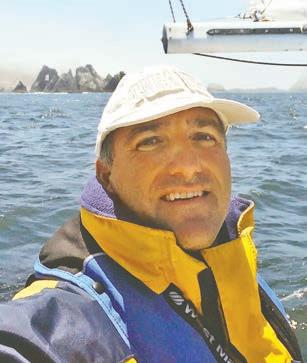
news of
ALL PHOTOS COURTESY THE FLOYD FAMILY As the cancellations continued to roll in, we received word that SailGP, the global stadium sailing league now in its second season, would not be coming to San Francisco on May 2-3 after all. (The New York event is still on for June 12-13 — at least it was as of this writing.) Last year, SailGP conflicted with the Great Vallejo Race, the YRA's season opener that draws well over 100 entries. This year, the YRA and Vallejo YC kindly moved the GVR to the last weekend in April so that local sailors could enjoy one regatta as participants and the other as

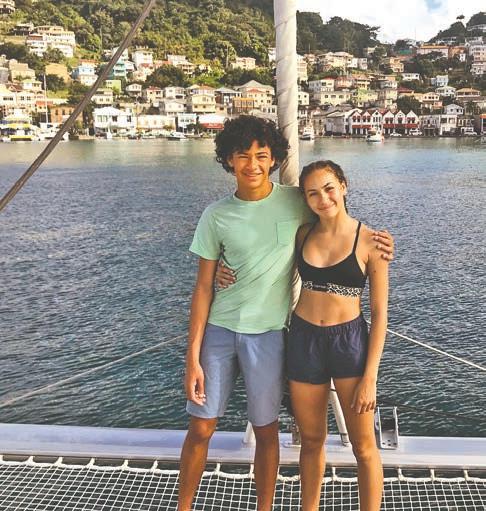
the bay
spectators. The good news is that the GVR has already been rescheduled: Mark your calendars for October 10-11, and we'll see you there.
Sadly, we won't see you at the Pacifi c Sail & Power Boat Show on April 16-19. That has been canceled. We had a glossy boat show guide all printed and ready to be inserted into this issue, and we commissioned Jim DeWitt to paint us a cover. You can see that we at least got to keep the great cover!
Local races have been canceled
continued in middle column of next sightings page
pac cup family — continued
been many highlights, from singlehanding around the Farallones, to an awesome crew for Friday night racing, to special weekends on the moorings at Angel Island listening to jazz."
Ryan said there's no hard-set plan after arriving to Hawaii. "I imagine we will do a lot of racing. Really, I'll do whatever the kids want to do, because to some extent, as long as I'm on the water, I'm happy." Ryan said that the family plans to keep chartering in warm-water locations, with locales like Croatia, the South Pacifi c and Thailand being high on the list. "Julie loves sailing and traveling, so naturally we are thinking about casting off the lines at some point, but with a much bigger boat, and likely a cat. You get spoiled on the charters. I am loving the journey and trying to enjoy each turn it takes. I still have a lot to learn."
— tim
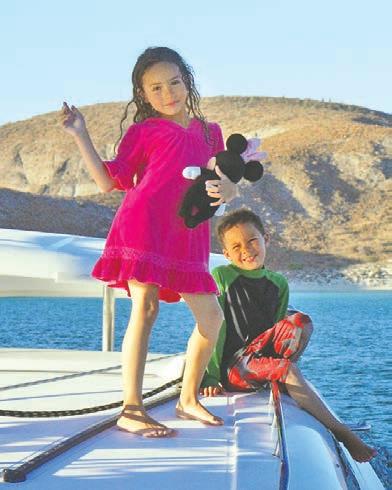
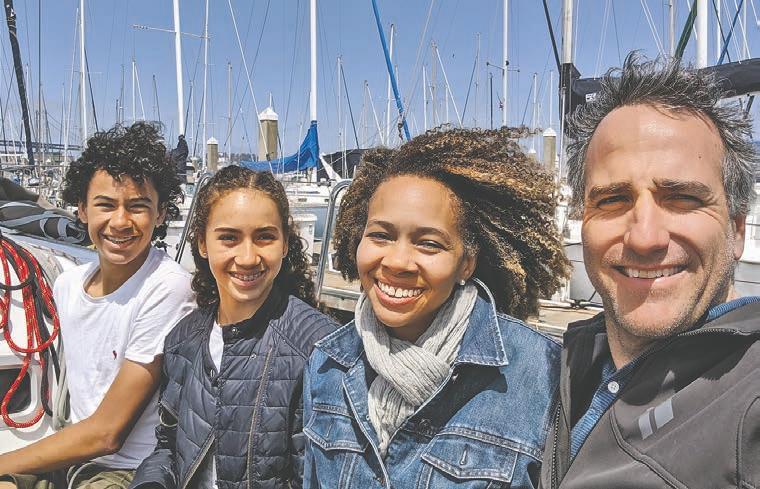



The Floyd children have literally been sailing since before they were born. Top right-hand photo, from right: Ryan, Julie, Sammie and William.
new girl on the block
Wilbur Spaul achieved a signifi cant milestone in his bid to sail the smallest boat to Hawaii: In February, he chainsawed the 8-ft Chubby Girl into pieces and tossed them into a dumpster. Her slightly longer, signifi cantly lighter, and hopefully better-sailing sibling is currently under construction. As you may recall from a Sightings in the October 2019 issue, Wil is a longtime sailor and cruiser, with the equally longtime dream of doing this passage. His inspiration — and the person to whom he will dedicate the voyage — is Gerry Spiess, the current smallest-boatto-Hawaii record holder. In 1981, Spiess sailed the 10-ft Yankee Girl from Long Beach to Honolulu. It took him 34 days. Spaul designed and built the recently-departed Chubby Girl out of
continued on outside column of next sightings page
news of the bay
through April 7. Our guess is that the shelter-in-place order will extend beyond that and so will the mad dash to cancel or reschedule events large and small.
Once the orders are lifted, the Coast Guard will consider marine event permits on a case-by-case basis. "It very much will depend on what the federal recommendations will be regarding social distancing (after the shelter-in-place orders are lifted)," writes the YRA, "and how event organizers are going to ensure that those recommendations can be followed, for both

Clockwise from top left: An unceremonious end to the original 'Chubby Girl'; Cree Partridge has shepherded countless custom boats through the process of conception to reality; The original 'Chubby Girl' CAD design; How do you sail a 9-ft boat across the ocean? You basically turn it into a fl oating food locker; Partridge, the man with the building plan.



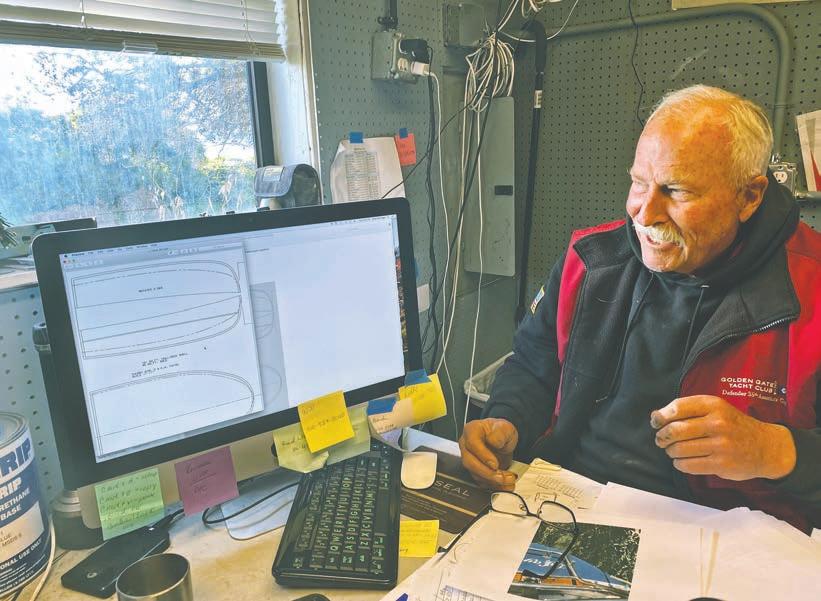
— continued
the sailors and the race committee."
Among other races canceled were BAMA's Doublehanded Farallones on March 28, and all of St. Francis YC's events through mid-April. The YRA is keeping up with Bay Area races on a weekly basis and posting updates on their website at www.yra.org. With safety always a top priority, the Pacific Cup Yacht Club has moved their Pacific Offshore Academy prep seminars online. Anyone interested can participate
continued in middle column of next sightings page
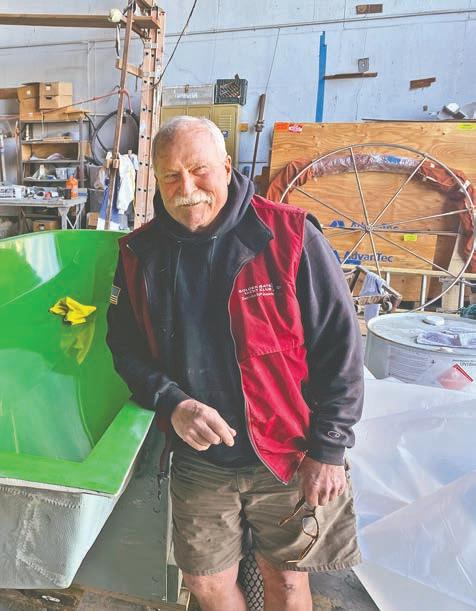

LATITUDE / MITCH
WWW.CHUBBYGIRLCRUISING.COM
new girl — continued
glass-covered plywood in a friend's garage in Walnut Creek. He began sea-trialing the boat out of Berkeley last spring. Despite a new set of sails from Pineapple, and design assistance from El Sobrante Naval Architect Jim Antrim, progress — and performance — was slow and a bit disappointing. "Once I got all the stores and equipment aboard, it was just too heavy," says Wil of the little boat. "Very sluggish, not responsive, even in good breeze." After 10 months of tweaking and trying, it was chainsaw time. Wil is one of those indomitable-spirit guys. He saw it as less of failure than just another speed bump in the learning curve. So, he's building a new Chubby Girl in a corner of Berkeley Marine Center (which is mostly deserted because of the current crisis). The new boat is a Jim Antrim design. Both Jim and BMC's Cree Partridge have been mentors, friends and invaluable consultants in the process. When Spaul commissioned the design, says Jim, "My mind went reeling over the expense of producing ideal shapes for an oceancrossing little boat." Cree, who has built Antrim designs at BMC such as the Class 40 California Condor and canting-keel Antrim 49 Rapid Transit, suggested using a dinghy mold they already had at the yard. It was a scow-bowed dinghy Jim had drawn for a client as a tender on his cruiser. Cree also had the clamshell idea. The . . . what? For ease and expediency of building, the new Chubby Girl looks like (and is) a giant clamshell made from two dinghies. The hull and 'top' are both out of the same mold. They are joined in the middle by a 15-inch spacer. Construction is vacuum-infused foam/fiberglass sandwich, which, when completed, will yield a 9-ft boat around 600700 pounds — about a third less than her predecessor. The new mast will be slightly taller, but Spaul will be able to use many of the same rigging parts, sails, and other equipment from the first boat. Continuing the "something old, something new, something borrowed" theme, the keel fin is a piece of an old daggerboard from Rapid Transit. Spaul could be a poster boy for '70 is the new 40.' He is full of energy, enthusiasm and dogged persistence. With the help of Raphael, a young Brazilian eager to learn boatbuilding, Wil works on the boat 12 hours a day, 7 days a week. "I need to stay ahead of him with the design, so a couple of times, I've had to tell him to stop building and go home!" says Antrim.
If all goes as planned, Spaul plans to start sea-trialing next month, and hopes to depart for the Islands in May. We'll be bringing you updates on the Chubby Girl project as it progresses. In the meantime, check out www.chubbygirlcruising.com.
— jr
the betts/wylie quest
What do Jim Betts, Tom Wylie and SoCal sailor Charles Ray have in common? A new boat that follows the respective builder's, designer's and sailor's never-ending quests for performance. Founded in 1970, Betts Boats is based in Anacortes, Washington. The legendary Betts is known for building high-performance sailing yachts, including boats for the America's Cup, Admiral's Cup and Transpac. Among the current projects listed, you'll find one for a Wylie 60. The boat, off the board of longtime yacht designer Tom Wylie, is the latest in a line of Wylie's popular wishbone catboats. She features a carbon-fiber composite construction, lithium battery power system, and a carbon keel fin and lead bulb. She's being built for Southern California sculptor Charles Ray, an interesting fellow to chat with, and an enthusiastic sailor. Ray grew up in the Chicago area and sailed dinghies in the Great Lakes, including prams, Lasers and the Flying Dutchman. Like most
the bett's/wylie quest — continued
sailors, his small boats became bigger boats: an 8-Metre, then a Pelican, followed by a Lapworth 24 named Glass Slipper (hull #1), a C&L 36 for cruising, an Olson 40, and so on. He eventually ended up sailing the Wylie 44 C-Squared, which his wife describes as "a huge sail that we all hold on to." And now, Ray has stepped up to his latest boat, the Wyliecat. When asked why he chose this design, he emphasized over and over that it came down to performance and ease of handling. Ray loves the solitude of singlehanded sailing, and the Wylie catboat lets him do that without sacrificing performance. Having no headsail to contend with makes for an easy boat to take out singlehanded for a day (or longer). This new Wylie features a forward cockpit area for those times when guests are onboard, and an aft cockpit for helming the yacht. In other words, his guests get to enjoy a day out on the water, while Ray gets to enjoy sailing. Another unique feature of the boat is its electric-drive motor, which fits comfortably in the space below the cockpit. A retractable prop provides some charging, and while the range on a single charge isn't going to get Ray hundreds of miles of travel distance, it easily handles 15 to 18 miles, more than enough if the wind gives out on a daysail. Ray still loves the challenge and performance he gets out of flying a spinnaker, even when singlehanding, so Tom Wylie worked the design to include a Samson post/spinnaker pole assembly that allows the spar to be used as either a bowsprit or a more traditional spinnaker pole. This new Wylie 60 is, in Ray's own words, "a unique boat." With its easy-to-sail rig (significantly less running rigging) and the performance levels that are typical of a Wylie-designed boat, Ray figures he's got another 10 to 15 years of singlehanded and doublehanded sailing ahead of him. His busy lifestyle means he doesn't have the time to prepare and carry out a full-blown race campaign, but that doesn't mean he has to compromise when it comes to the one metric that keeps him coming back to the water: that never-ending quest for performance. — eric rouzee
dollars and sense
"How did you do it?" That is one of the most frequent questions we're asked about our years spent cruising. Because when you're 42, intentionally unemployed, and living your cruising dreams, curiosity wins out. Here were some common questions: "How could you both retire so young and take your kids sailing?" "Did you sell off one of those startup, dot-com companies?" "Did a rich relative die and leave you money?" "Did you sell your house and everything to do this?" "Did you hit the lottery?" "Oh, how can you be so lucky?"
Yeah, so lucky. I recalled that after I handed over the cashier's check to purchase our little sailboat, we'd had more pocket money as poor, married college students than we had at that moment! But part 1 of the plan was in place. We had our boat. Now the reality of part 2, saving for our cruising kitty, was staring us in the face, and once again, we were starting from scratch. If that weren't challenge enough, we also had a toddler and a newborn. I was thankful that our passion to fulfill our dream and our material sacrifices had seen us clear to find and purchase our boat, but how were we going to generate enough savings to sustain us during our adventure? We debated how we should structure our cruising kitty. We could either: A) Build a nest egg and draw it down to zero, or B) Bank enough principal so we could live off the interest and not touch the nest egg.
news of the bay
RAY CHARLES live, or view the archived seminars later. Access them for free online at www.pacificcup.org. Meetings and other peripheral activities of yacht clubs and other organizations have also moved online. (Our staff have even been invited to a TGIF party to be held via Zoom!)
Along those lines, US Sailing instituted a new feature on their website called The Starboard Portal. "Stay connected with sailing through new videos, live presentations and interactive discussions," they say. Check 'em out at www.ussailing.org. In order to keep our readers informed, Latitude 38 has created a new web page called Sailing in the Times of Pandemic. This page collects all the coronavirus-
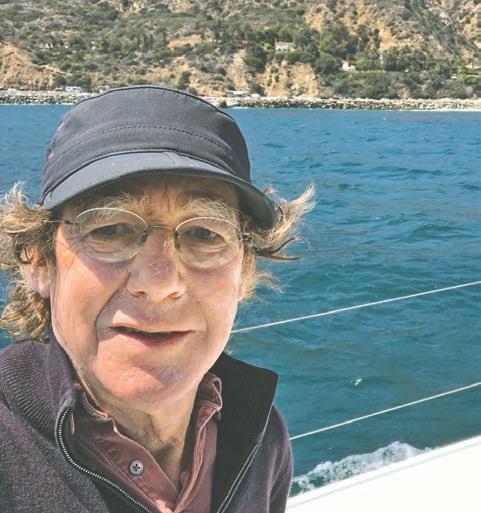
YOUTUBE / JONATHAN WESTON
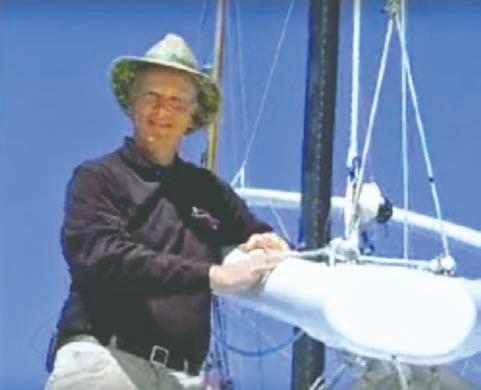
— continued
related stories from 'Lectronic Latitude into one tidy feed. Find a link to it on our home page at www.latitude38.com.
The world of virtual regattas and instructional videos can help us at least keep our mental chops up. Connecting with one another via social media or other apps can help keep our spirits up. And a daysail solo — or with members of your own household, per public health guidelines — can do wonders to freshen your mind and exercise your body.
Remember that the marine industry, with some careful adjustments, is still open for business, in case your boat needs something — or in case you need a boat.
Sláinte, dear readers!
— chris
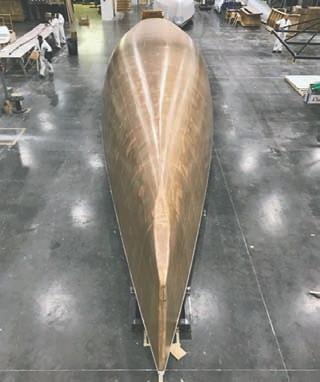
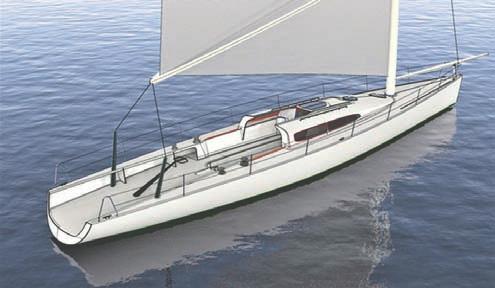
WILL PORTER WWW.BETTSBOATS.COM
dollars and sense — continued
There were pros and cons. Plan A forced us to return home when we drained the cruising kitty dry, while plan B allowed for an openended adventure. I leaned towards plan B. I realized that this would be a greater temporary financial hardship, but I dreamed of an adventure without a set end date. Imagine how frustrating it would be to settle into the cruising lifestyle, and then be forced to pull the plug when you weren't ready to give it up. But the question remained: Could we save enough money within a realistic time frame to live solely off the bank interest? I came up with a WAG (Wild-Ass-Guess) as to our future cruising expenses, and then Bruce built in a little fudge factor. Next, he ran some calculations to estimate how much money we needed to sock away in an investment to be able to draw out enough money to support ourselves month after month: 12 E/RT = S Where: E = Estimated monthly expenses; R = Expected investment interest rate of return; T = Anticipated months of savings; S = Monthly
continued on outside column of next sightings page

Clockwise from top left: Southern California sailor Charles Ray snaps a selfie; The new Wyliecat 60 is in its nascent stages at Betts Boats in Anacortes, Washington; Charles Ray singlehands his Wylie 44 'C-Squared', which Ray's wife described as "a big sail that we all hold on to"; What performance will look like: a CAD rendering of the new Wyliecat 60; Yacht designer extraordinaire Tom Wylie aboard the 'Derek M. Baylis'.
dollars and sense —
savings required.
I sat quietly watching Bruce run and then rerun the numbers. I could see by the look on his face that our cruising dream might come crashing to a halt right then and there. "Is it doable?" I asked. Bruce shook his head, "I don't know." He turned the calculator around so that I could see the display. The numbers revealed that the required savings would consume well over half of Bruce's paycheck each month. Even for our frugal family it was a pretty steep expectation. Bruce spun the calculator around and started punching more numbers. I watched in silence knowing we were going to come up short. Is this where it would end? For five minutes I sat and listened to the clicking of the calculator keys and observing Bruce shake his head. Suddenly he looked up with a grin "I think we can do this." He paused and went back to his scribbled notes and his finger raced across the calculator keys one more time. Bruce made some additional notes and looked up wanting to know if I was ready for a crazy idea regarding the mortgage payment. Was it essential? We could sell our three-bedroom house and really boost the cruising kitty, but then we would lose our stake in the strong Bay Area housing market. I feared that once we sold, we'd never be able to buy our way back in. After some deliberation, the answer turned out to be as simple as not selling but downsizing our house. Selling our house and buying a smaller townhome meant we could still
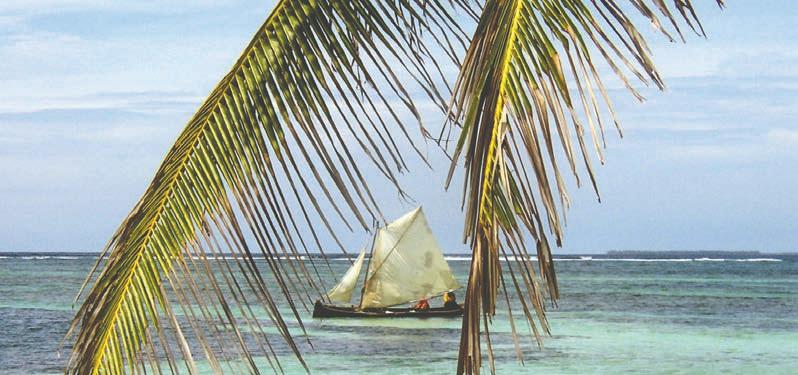

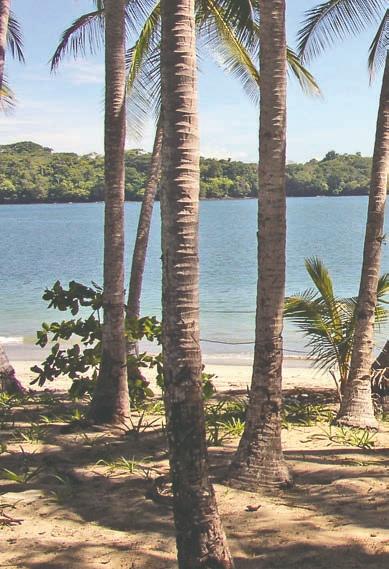
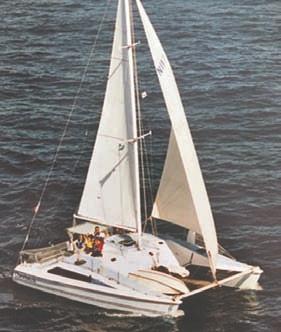
affording the cruising life
stay in the housing market, but substantially boost our cruising kitty by banking the difference. I nodded, reasoning out loud, "a smaller house would be easier to rent, especially if it had no yard, and if we are careful, the rental income will cover the mortgage and property taxes and our net outlay will be zero." That's a lot of if's, but as the pencil moved from column to column, I could see our plan coming into focus.
Out came a clean sheet of graph paper. I sharpened my pencil and we got more serious, honing in on our actual fi nancial commitments. We determined — to the penny — how much we were truly living on per month. I had an idea, but was a little surprised when we broke it down into categories and columns. Bruce basically had two

Clockwise from top right: What price can you put on exotic locales, like Ulu San Blas in Panama?; the Winships' 33-ft Crowther cat 'Chewbacca' in Isla Gamez, Panama; off the coast of Costa Rica, 'Chewbacca' lookin' good; the Winship family at the Panama Canal.
columns: essentials and nonessentials, or what I referred to as needs vs. wants. Food and utilities went into column #1, while eating out and new furniture went into column #2. This didn't mean we couldn't eat out, it only highlighted that it was nonessential, and it was up to us to make that choice. I could already tell where my daily Starbucks fund was going to land! As the columns fi lled in, Bruce highlighted which costs or outlays would not be following us on our adventure. House insurance, mortgage payment and car insurance were highlighted, but they were soon replaced in the bottom column by boat insurance, boat maintenance and estimated marina expenses.
Once we fi gured out our bare-bones living expenses without any frills, I trusted that our basic needs and wants wouldn't drastically change after we set off cruising. I also trusted that we could maintain self-control when it came to our spending, just as we had when we saved for the boat purchase.
However, like anyone else launching a new endeavor, I only had a general idea of how much full-time cruising would cost, and I wouldn't know for certain until we were out there living the life.
To motivate the savings effort, I crafted a chart to help track our progress and hold us accountable to our fi nancial goals. A not-so-subtle three-foot-tall fundraising thermometer — hardly a piece of romantic bedroom décor! — hung behind the door, and charted our monthly fi nancial progress. Some months, it was hard to save. Decembers were an especially tough time to maintain our budget. We didn't want Mr. Grinch to steal Christmas from our daughters, so we learned to browse for Christmas bargains year-round. We didn't rule out shopping at garage sales and second-hand stores, and I was astounded how these simple cost-cutting practices translated to savings month after month, and year after year. I couldn't always color in our savings thermometer, and there were times when progress seemed painfully slow, but we pressed on. "Stay focused and keep your eye on the prize," was my unwavering mantra as I stared at a photo of a tropical island anchorage taped to our bathroom mirror.
We gave ourselves a fi ve-year window, and as the months ticked by, the satisfaction we both felt while watching our savings grow was fuel enough to push us forward. When the time came to begin outfi tting the boat, I often walked along the deck with a notepad in hand while Bruce dictated what gadget or gizmo he thought we needed to install. Sometimes I would question him if this was a want or a need! Then we switched places, and I would add my vision for our little home on the water while Bruce scribed and asked if this or that was an essential or nonessential item! Sixty months later, we colored in the last blank space of the savings thermometer and toasted to our future. It was a long road, but at last our family was ready to embark on our cruising dream, and our little boat took us down the Mexican coast, along Central America, through the Panama Canal and on to South America. Mission accomplished. — april winship
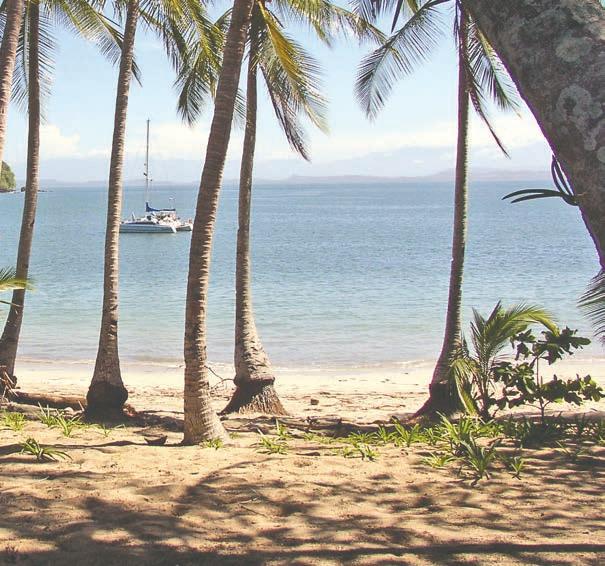

The Winships have penned a book about their family's 10-year adventure cruising aboard their 33-ft catamaran Chewbacca. Set Sail and Live Your Dreams (Seaworthy Publications, 2019) is available at www.seaworthy.com, as well as on Amazon.
Ask a cruiser about their plans, and they're likely to laugh. On any given day, a bluewater sailor will probably tell you that they're doing "Boat projects," but ask them to elaborate on the weeks and months ahead, and they'll likely shrug, and say, "We'll see how it goes." Most cruisers will tell you that they started with a one- or two-year plan, which evolved into more ocean miles, more countries visited, more money, and more years of their lives. Out of necessity, cruisers develop an adaptive mindset, because cruising life heeds to weather above all else, followed by budgets, bureaucracies, health of both body and vessel, and plain old luck. Plans are important, but they're just dreams and aspirations. Reality cannot be forecast, and follows no schedule. By going with the flow, cruisers employ a mentality that gives them the patience and persistence required to navigate the Seven Seas. This relaxed, expectation-free philosophy is often an essential part of the escape from their former hectic land lives, even if they didn't know it when they first left the dock.
The cruiser's mindset might be the perfect mantra for the times we live in, as the planet grinds to a halt and holds its breath. One must simply adapt, try to find the safest port, and wait out this terrible storm. I left for New Zealand on a working vacation in early March, where I wanted to get a taste of the cruising life. I was planning to visit friends, catch a ride here and there on a boat, and meet up with some of Latitude 38's 2019 Pacific Puddle Jump fleet. Not long after I arrived, the world went into lockdown due to the coronavirus pandemic. Several popular cruising destinations have since closed their borders, and many cruisers' plans evaporated as quickly as they'd been made.
But none of this seemed to bother the cruising community, which had long become used to adjusting their plans for myriad reasons. I would learn that the name of the game is to take changes in stride, and to adapt to any conditions that may come one's way.
Changes in Latitude's veterans Lewis and Alyssa Allen with their Island Packet 420 'Levana'. (The boat is for sale!) I was docked next to the couple in Marsden Cove, near Whangarei, New Zealand, in mid-March.
After a lifetime of sailing, I thought I'd have no trouble fitting in on any boat cruising in any waters. While I'd never owned a bluewater boat or cruised with others for any length of time, I thought it would be easy to settle into the life. My first sailing meet-up would start in the Northland region; we'd head south from there. Cruising in 'the land of long white clouds' — New Zealand's moniker — has been a lifelong dream. My friends had a hefty but manageable list of boat projects that needed to be done (though I would later find that there was the "day-to-day list," as well as the "big list"). Day one started with errands onshore, which meant constantly running into the tight-knit community of a shoreside cruiser's haunt. (It was nice to meet people, but one could easily lose the day, or days, catching up.) There were countless conversations that went something like this: "When are you leaving?" "We're not sure; today, we think. What about you?" "We're not sure, in a few days, we think. Where are you headed to next?" "We're not sure. South, we think. It depends on the weather. What about you?" "We're not sure. North, we think. It depends on the weather." Granted, there were details lost on me, an interloper, but clearly, there was a noncommittal attitude toward long-term plans. When we finally departed in the late afternoon, we enjoyed a leisurely sail downwind before turning the corner of a windy point and slogging into 15 knots and short, steep chop. The skipper



ELANA CONNOR
Red sky in the morning . . . On March 16, I sailed out of Tutukaka Harbour, seeking refuge to the south as Cyclone Gretel bore down on the North Island of New Zealand. At the same time, a viralstorm was bearing down on the entire planet.
decided to head back to a more protected anchorage, with plans to sail the next day. But the next day brought more items on the list, including cleaning the bottom, which took longer than expected. Once that task had been accomplished, the forecast showed rain and gusty wind for the next 30 hours. Staying put seemed like the best call; we lingered at the same anchorage for another night. I was just happy to be in New Zealand; we had Wi-Fi, and I was able to do some writing for Latitude, as well as help my friends work on the boat. I immediately found myself recalibrating my expectations — mostly by avoiding expectations at all (like having any kind of schedule). This was a critical lesson learned about the cruising life.
Not long after our unexpected two-day stop, a cyclone appeared in the forecast. And, not long after that, the coronavirus took hold of the world.
Imet Darrell and Gayle Smith in Whangarei, NZ. The city of nearly 60,000 is known for its abundant marine services, friendly technicians, affordability, and abundant marinas and boatyards. One-time Bay Area residents who are now in their 60s, the Smiths have been cruising for nearly 12 years. The couple sailed through the South Pacific with the 2019 Pacific Puddle Jump fleet before making landfall in Opua, New Zealand. "When Gayle was in school," Darrell told me, "I needed something to do. So I started taking lessons at Tradewinds Sailing. I took all the courses, from advanced coastal cruising to celestial navigation. Once you were qualified, you paid a flat fee and could sail as much as you wanted. So we took friends out to Angel Island and anchored overnight."
Darrell said that the aha moment came when he and Gayle chartered a boat in Greece and sailed from Athens to the island of Kos in 2006. "That set the hook," Darrell said. "I thought, 'We can do this.'" Two years later, the couple bought their Spencer 53 Gone Bambu in Seattle, and sailed to San Francisco. "It was a disaster," Gayle said of the passage. (I'm paraphrasing a bit here, as this conversation was late at night and after a few glasses of wine.) "We had a schedule, and we tried to stick to it. That was a mistake." After a few years in the Bay Area, the Smiths have gone on to cruise through Mexico, Central America, the Caribbean and Panama, American Samoa and French Polynesia, just to name a few places. They had friends who were scheduled to meet them in New Zealand, but their friends had to cancel because of the coronavirus epidemic. When I was meeting with the Smiths, several countries, all of which are destinations for cruisers departing New Zealand for the winter, announced that they were closing their borders to private yachts. (The exact details are
Elana Connor captured a selfie as she rounded Cape Brett and the Bay of Islands' famed (if simply named) "Hole in the Rock."
